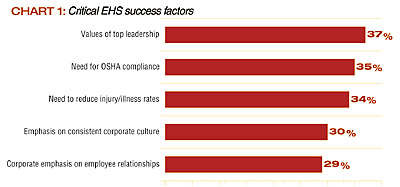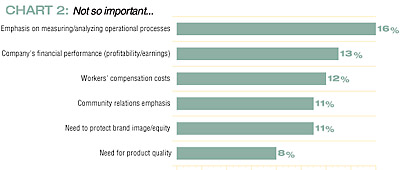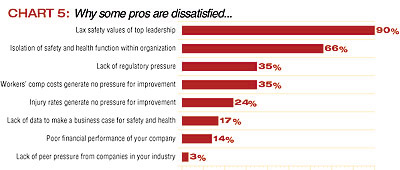
How do safety and health pros get budget and staff increases?
What drives companies to invest in safety and health? Why are some pros satisfied in their jobs, and others are not?
Timely questions, wouldn’t you say? Especially given today’s shaky business climate. You’ve seen the headlines: “How safe is your job?” “Surviving the slowdown.” “The return of the crummy job.”
To give you a benchmark of how safety and health departments — and professionals — are faring in today’s organizations, Industrial Safety & Hygiene News surveyed a select group of readers (see sidebar). Hopefully, our findings will give you insight into how to position and market your program — and yourself.
Note: Several times in this report we’ll ask for your reaction to what you’re reading. Compare your own experience to these survey findings. We’ll collect comments for a follow-up article in a future issue. Contact information is provided at the end of this article.
Survey demographics
ISHN’srespondents represent the upper echelon of the safety and health profession. More than 80 percent have four-year college degrees, and 46 percent possess graduate degrees. Most have professional certifications such as Certified Safety Professional, Certified Industrial Hygienist, or Professional Engineer.They work for large businesses: 50 percent are employed by firms with more than $1 billion in annual revenues. Their scope of responsibilities is broad: 29 percent work at the corporate level, 19 percent oversee divisions, 27 percent handle multiple facilities, and 17 percent work in a single facility. They cover a mix of safety, industrial hygiene, health, environmental, fire and security issues.
On average, ISHN’s respondents have 15 years experience in the safety and health field, and have worked 14 years with their current employer. They’ve been in their current job for an average of six years.
Where’s the chaos?
Turmoil? What turmoil? That’s the initial reaction after reviewing responses from our survey. Consider this quote from aNew York Timesarticle from November, 2000: “Corporate America has entered a new stage of instability… the pace of change is clearly at an unprecedented level.”Closer to home, recent headlines from the safety and health business press include, “The Decline and Fall of the Industrial Hygiene Empire?” and “A profession in transition: Where do we go from here?”
This hand-wringing doesn’t come across in the survey. Fifty-three percent of ISHN respondents are either “satisfied” or “very satisfied” with their company’s support for safety and health. Less than one in five (18 percent) admit to being “dissatisfied” or “very dissatisfied.”
What’s the main beef? Inadequate staffing, according to 41 percent of ISHN respondents. Otherwise, professionals surveyed seem to be a contented lot. Less than 25 percent are unhappy with department funding, integration with other company operations, the involvement of top leadership, and safety and health’s impact on the shop floor.

Critical factors
So what’s behind the support and success that many professionals enjoy? What drives safety and health investments? We asked those “satisfied” pros to identify the three most critical success factors from a list of 16. See chart 1 for the top five keys to success.

Nothing beats the values of top leaders when it comes to getting support for safety and health, according to our survey group. It’s simply vital to success. But the need to comply with OSHA regs comes in a very close second. And injury/illness rates remain a major motivator. OSHA and injury/illness rates have driven safety programs for decades. What’s newer is the connection between safety and health and today’s emphasis on corporate cultures and employee relations.

Important personal skills
What are professionals personally doing to get the support they need? Our survey asked “satisfied” pros to identify the most important personal critical success factors. See chart 4 for how readers responded.Better hone those people skills — communicating and networking — if you want to get ahead, according to survey respondents. Readers say that’s more important than trying to put safety and health into financial terms, or showing how it contributes to quality.

Where support is lacking
So what about the roughly 20 percent of professionals surveyed — that’s one in every five — who are not happy with the support they receive in their organizations? What’s the problem? “Dissatisfied” pros were asked to identify three major causes of their discontent. See chart 5 for how readers answered.Again, it’s all about values, according to ISHN readers. It’s values, or more precisely the lack of safety and health values in top managers, that is probably responsible for the second most-common complaint: isolating the safety and health function in some corner of the company, cut off from mainstream business activity.
Lax values, pros say, will hurt safety efforts more than a quiet OSHA; a bad bottom line; or the absence of peer pressure, injuries or workers’ comp problems.

Communicating contributions
Given this emphasis on values, how do pros communicate the value of safety and health to their executive managers? See chart 6 for how ISHN readers answered the question.Clearly, readers are most comfortable using very traditional sales pitches for safety and health: compliance, loss control, and the “rightness” of a moral commitment.
About those business skills…
This raises the question: Just how important is making a business case for safety and health?“You’ve got to talk dollars and cents” has been promoted for decades in safety circles as an essential survival skill. More recently, there has been an ongoing search for performance metrics and formulas that will document safety and health’s bottom line contributions. Yet our survey results simply don’t show much regard for, or interest in, business skills. Consider:
- Only 34 percent of those surveyed say the ability to translate safety and health activity into financial terms is a critical personal skill.
- Only 17 percent of readers who are dissatisfied with their company’s support say the reason is the inability to make a business case for safety and health.
- Only 30 percent of all respondents describe the value of safety and health to top execs by documenting a return on safety and health investment.
Impressions
Given our small sampling base, these survey results are best viewed as a snapshot of current professional thinking. But every picture tells a story, and here’s one interpretation that can be derived from the responses:Safety and health pros are largely a contented lot in 2001. Most seem to have found a stable “home” in their organizations, carving out a technical/regulatory niche thanks to their specialized compliance knowledge and people/networking skills. They seem comfortable in their niche, and are doing OK without building a business case for their job. Instead, they rely on the values and culture of their organization — along with compliance mandates — for support and security.
This picture, if true, is surprising in light of the churning and instability widely reported in corporate America by the media. And it raises these questions:
Has the downsizing and demise of the safety and health profession been overblown?
Are values indeed more critical to safety and health success than making a business case?
Or do a lack of tools (metrics, software, etc.) and a lack of access to financial data hinder making a business case?
Could it be that the bottom line contributions of safety and health are just not significant enough to build a case for it?
Is there no executive demand for a safety and health business case?
Finally, is there a satisfied silent majority of safety and health pros secure in their niches — or is the profession denying realities that could threaten its place and future in corporate America?
Survey background
In December, 2000, ISHN mailed a four-page questionnaire to 1,000 readers in large facilities with 1,000+ employees. We received 164 responses from a useable base of 988 readers for a 16.6 percent response rate.Sidebar: Your turn
Tell us what you think. How do you react to our survey findings? A future issue of ISHN will offer responses from readers. E-mail us at: djsafe@bellatlantic.net, fax: (610) 254-9877; mail: ISHN, 237 Lancaster Ave., Suite 201, Devon, PA 19333.